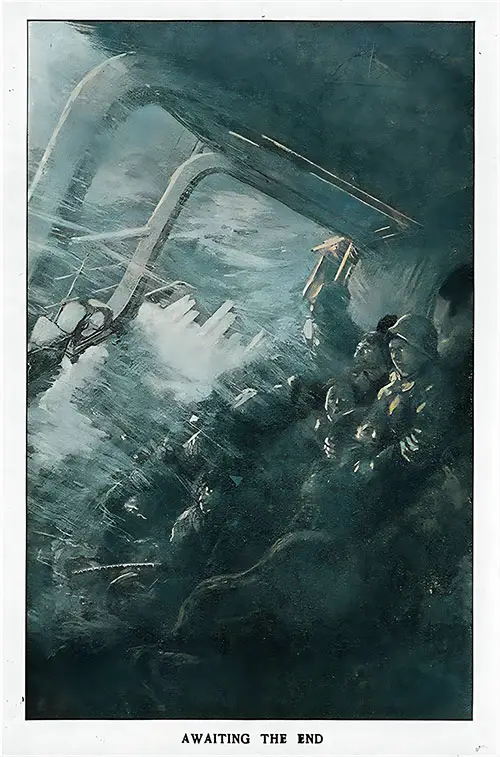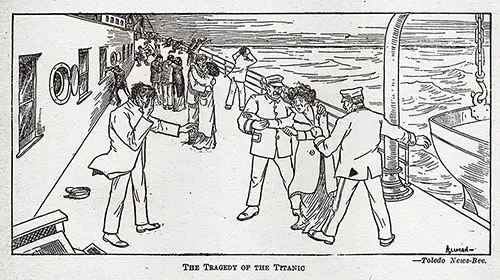RMS Titanic Images - Sinking
Illustrations depicting the sinking of the RMS Titanic on 14 April 1912, curated by the GG Archives from books, magazines, newspapers, and other sources.

The Sinking of the Titanic. As the mortally wounded liner neared the last moments of her death-struggle, the inrush of water to her forward compartments depressed her bow, leaving her stern clear of the water. Our artist depicts her as she appeared to the horrified survivors in the lifeboats just before she took her final plunge. 1,635 persons went to their death with her (according to the official estimate of the white star management) or perished afterward from exposure and shock, 705 persons survived the disaster, according to the most trustworthy figures available as the “weekly” goes to press. Drawn from descriptions of eyewitnesses by l. A. Shafer. Harper's Weekly (27 April 1912) p. 34-35. | GGA Image ID # 109dc2a899

This Picture Depicts What in All Probability Happened to the Titanic. She Struck a Massive, Projecting Underwater Shelf of an Iceberg, Ripping Open Her Bilges on the Starboard Side from Near the Bow to Practically Amidships. The. Energy of the Blow is Estimated at 1,161,000 Foot-Tons. © Scientific American. Marine News (May 1912) p. 157. | GGA Image ID # 10acc78937

How the "Titanic," the "Last Word in Marine Architecture," Was Crushed like an Egg Shell by the Submerged Portion of an Iceberg. On the night of April 14th, the ' Titanic," steaming at almost full speed through the darkness and through an ice field of which she had been warned by wireless, struck an iceberg and, despite the most modern devices and mechanical precautions which had led her builders to believe she was unsinkable, went to the bottom of "Sigsbee Deep," carrying 1,635 souls to death. The above drawing was made from descriptions furnished by survivors, and by scores of witnesses who testified before the United States Senate investigating committee at Washington. Popular Mechanics Magazine (June 1912) p. 800-801. | GGA Image ID # 1080d6589a

The Sinking of the Titanic. A Sequence of Sketches by Jack Thayer, a first-class passenger, and a survivor of the Titanic disaster. The then 17-year-old survived the sinking hanging on to the overturned Collapsible Lifeboat B later being picked up by Lifeboat 12. Jack, along with Harold Bride, Colonel Archibald Gracie, Charles Lightoller, and the chief baker, Charles Joughin managed to balance on the overturned boat for some hours before he was picked up. He was the only survivor to indicate that the ship broke into two pieces before sinking, his version, sketched out by him on 15 April 1912, confirmed by oceanographer Dr. Robert Ballard in 1985. Public Domain Image. | GGA Image ID # 10ef01cc8a

Made by a Survivor on an Overturned Collapsible Boat as the Titanic Was Sinking., Showing the Liner Breaking in Two: Sketches of the Stages of the Sinking of the Titanic Made by Mr. John B. Thayer, Jr. While He Was on One of the Vessel's Collapsible Lifeboats, and Filled in by Mr. I. P. Skidmore on the Carpathia Immediately after the Rescue of the Survivors. The Illustrated London News (25 May 1912) p. 783. | GGA Image ID # 1069bcd788

Illustration of the Damage Done to the Titanic Caused by an Iceberg. ln all probability a massive, projecting, underwater shelf of the iceberg with which she collided tore open several compartments of the Titanic, the rent extending from near the bow to amidships. The energy of the blow, 1,161,000 foot-tons, was equal to that of the combined broadsides of the Delaware and North Dakota. Scientific American (27 April 1912) p. 381b. | GGA Image ID # 10a4a3ccf2

Is This What Happened? In all probability, according to The Scientific American, a massive, projecting, underwater shelf of the iceberg with which she collided tore open several compartments of the Titanic, the rent extending from near the bow to amidships. The energy of the blow, 1,161,000 foot-tons, was equal, it is estimated, to that of the combined broadsides of the battleships Delaware and North Dakota. © Scientific American. The Literary Digest (11 May 1912) p. 981. | GGA Image ID # 10869441df

The Titanic struck a glancing blow against an under-water shelf of the iceberg, opening up five compartments. Had She been provided with a watertight deck at or near the water Line, the water which entered the ship would have been confined below that deck, and the buoyancy of that portion of the ship above water would have kept her afloat. As it was, the water rose through openings in the decks and destroyed the reserve buoyancy. The Unsinkable Titanic (1912) p. 125. | GGA Image ID # 100a665876

View of the RMS Titanic, 15 Minutes Before She Sank. The Illustrated London News (18 May 1912) p. 748-749. | GGA Image ID # 1011850432

Drawn from Material Supplied by Mr. J. B. Thayer, Jr. and Mr. H. Senior, Survivors: The End of the RMS Titanic. She Turned Right on End and Made a Big Plunge Forward: The Titanic Going down in Two Miles of Water, after Collision with an Iceberg. The Illustrated London News (18 May 1912) p. 752-753. | GGA Image ID # 106908038a

A Drawing by G. A. Coffin of the Sinking of the Titanic last Monday Morning at Three O'Clock. The New York Observer (18 April 1912) p.488. | GGA Image ID # 100e9f1152

The Greatest Shipwreck in the World's History: The Loss of the Titanic, Featured Photos Were The Sumptuous Appointments of the Titanic -- The Parisian Café with its Trelliswork and Climbing Plants; Boats which Rescued Some of the Passengers -- Seen to the left of Promenade Deck; A Sitting Room of a Private Suite; The Swimming Bath; Cycle Rowing Machine in the Gymnasium; How the White Star Liner Titanic Encountered the Iceberg Stream from Greenland Waters; and The Gymnasium. The Sphere (20 April 1912) p. 48-49. | GGA Image ID # 10f9026965

The Question of Pressure Upon the Sunken Titanic. Diagram Showing the Increase of Pressure as the Depth of the Ocean Increases. The Sphere (27 April 1912) p. 73. | GGA Image ID # 10fdab3376

The Question of Vortex: How Far the Action of Suction and Disturbed Water Extends. The Theoretical View of Vortex Action-Diagram Showing Danger Limit According to Generally Accepted Theory. New Objects Are Drawn Down With a Sinking Vessel. New Vortex Action Can Be Easily Studied - a Simple Experiment. The Sphere (27 April 1912) p. 74. | GGA Image ID # 10fde5860c

Diagram III: How the "Titanic" Gradually Sank Bow First with Her Lights Blazing Til the Last. The Sphere (27 April 1912) p. 6-7 of the Supplement. GGA Image ID # 10ffda0600

Diagram V: The Last Phase. The Titanic Slowly Tilted Straight on End. The Sphere (27 April 1912) p. 9 of the Supplement. GGA Image ID # 10fffeabda

The Titanic Poised Before the Plunge. For fully five minutes, according to a man in a lifeboat, the Titanic hung almost vertical in the water, with the stern towering one hundred and fifty feet above the sea. Then she lunged forward and slipped from sight. The forward bulkheads had given way with a dull thundering report, one after the other, and the inrushing water slowly tilted the ship. The World To-Day (June 1912) p. 2376m. | GGA Image ID # 1097378844

Artist Depiction of Titanic Sinking - 1912. | GGA Image ID # 107da244bd

Destruction of the Titanic. Wreck and Sinking of the Titanic (1912) p. 34. | GGA Image ID # 108a4f13cf

Awaiting the End. Wreck and Sinking of the Titanic (1912) p. 209. | GGA Image ID # 1091098e9d

The Tragedy of the Titanic. © Allman/Toledo News-Bee. Wreck and Sinking of the Titanic (1912) p. 215. | GGA Image ID # 1091a8d213
